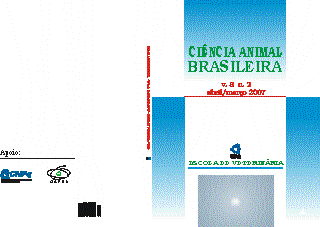DETERMINATION OF DENTAL CRONOLOGY OF MALE BUFFALOES (Bubalus bubalis) RAISED IN PARÁ STATE, BRAZIL
DOI:
https://doi.org/10.5216/cab.v8i3.1730Keywords:
Dentição, Búfalos, cronologiaAbstract
The present study had the purpose to identify the age of male buffaloes from Pará State, Brazil by teeth evaluation (incisive teeth). There was utilized 174 animals from zero to 100 month of age, without breed distinction and different farms in Pará State. Animals were separated in eight groups by age. Results showed the absence of 4th pair of incisive teeth (milk teeth) in animals aging between zero and three months. The 4th pair of incisive teeth was established definitively in animals aging between three and six months. After six months of age, animals had all of milk incisive teeth established. At 24 months of age was observed exchanges of the 1st pair of incisive teeth. Between 30 and 55 months of age occurred the exchanges of 2nd and 3rd pair of incisive teeth, respectively and above 55 months of age, animals had the exchange of 4th pair of incisive teeth. All permanent incisive teeth were established in animals aging between 55 to 100 month.
KEY-WORDS: Buffalo, teeth, age.
Downloads
Downloads
Published
How to Cite
Issue
Section
License
Authors who publish with this journal agree to the following terms:
- Authors retain copyright and grant the journal right of first publication with the work simultaneously licensed under a Creative Commons Attribution License that allows others to share the work with an acknowledgement of the work's authorship and initial publication in this journal.
- Authors are able to enter into separate, additional contractual arrangements for the non-exclusive distribution of the journal's published version of the work (e.g., post it to an institutional repository or publish it in a book), with an acknowledgement of its initial publication in this journal.
- Authors are permitted and encouraged to post their work online (e.g. in institutional repositories or on their website) prior to and during the submission process, as it can lead to productive exchanges, as well as earlier and greater citation of published work (See The Effect of Open Access).




























